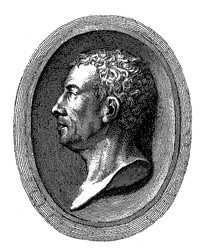Vinzenz Kininger (1767-1851) schuf das große Schabkunstblatt nach einem Gemälde seines Lehrers Heinrich Füger (1751-1818), Direktor der Wiener Kunstakademie. Dargestellt ist eine Szene aus Homers "Ilias". Der griechische Held Achilles sitzt an der Totenbahre seines von dem Trojaner Hector erschlagenen Freundes Patroklus und sinnt mit Schwert in der Linken auf Rache. Das Haltungsmotiv des Achill entspricht einer damals in der Akademie häufigen Pose, die den Torso vom Belvedere nachstellt.
Bez.:
u.l.: peint par H. Füger
u.m.: Imprimé par Senn
u.r.: gravé par Kininger
darunter:
u.l.: Le tableau original se trouve dans la galerie de la Societé patriotique des beaux - Prague -
u.r.: A Vienne, au Bureau d’Arts et d’Industrie, 1802
Titel u.m.:
ACHILLE
medilant la Vengeance de Patrocle.
Schenkung Dr. Axel Rügler
en

